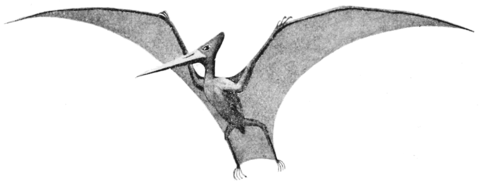of years, some of them at least, because of their comparative insignificance among their many powerful relatives. Of these relatives, the huge dinosaurs, the swimming ichthyosaurs, plesiosaurs and mosasaurs, and the flying ornithosaurs, with others scarcely less renowned in geological history, are known only from the scanty records of the rocks.
Of all the reptiles of the past, perhaps the most extraordinary, the ones which departed most from the reptilian type in form and habits, as well as the most highly specialized of all cold-blooded animals of the past or present, were the ornithosaurs or pterodactyls. They made their appearance in geological history, so far as is known, suddenly and in a highly developed state; we know nothing of their antecedents, nor indeed of their descendants. They flourished through millions of years in great numbers and multitudinous forms, and then, evidently, as suddenly disappeared. So different were these flying creatures from any others of the past or present that their proper place in the animal kingdom has been disputed. They were at first thought to be birds, and so described; and this idea of their relationship found expression in the name by which they are more properly known, the ornithosaurs or bird-reptiles. Some authorities would even yet give them a place all their own among animals, coordinate with the birds and reptiles. But they are now so well known to students of extinct life, and in so many forms, that there can scarcely be longer a serious question of their real, though highly modified, reptilian affinities. It is not impossible, however, though somewhat improbable, that they were, unlike others of their class, warm-blooded animals; it is at least highly probable that their circulatory and respiratory systems reached a much higher degree of perfection than is the case in any cold-blooded animals of the present time.
As flying organisms they attained the highest degree of specialization that has ever been reached among animals with a back-bone, at least so far as their skeleton was concerned. Some of them, indeed, seem to have nearly lost all other powers of locomotion—they could move through the air only. Furthermore, the relative proportion between volant surface and body-weight in some of these pterodactyls has been


